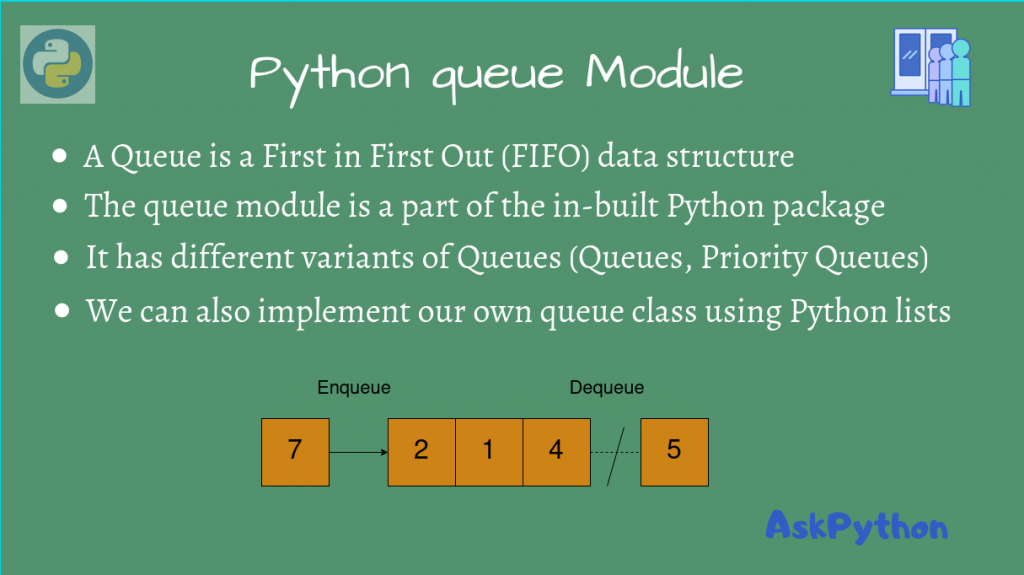In this article, we shall look at the Python Queue module, which is an interface for the Queue data structure.
Python Queue
A Queue is a data structure where the first element to be inserted is also the first element popped. It’s just like a real-life queue, where the first in line is also the first one out.
In Python, we can use the queue module to create a queue of objects.
This is a part of the standard Python library, so there’s no need to use pip.
Import the module using:
import queue
To create a Queue object, we can instantiate it using:
q = queue.Queue()
By default, this has a capacity of 0, but if you want to explicitly mention it, you can do so using:
q = queue.Queue(max_capacity)
Queue.get() and Queue.put() methods
We can insert and retrieve values into the Queue using the queue.get() and queue.put() methods.
Let’s create a queue and insert numbers from 1 to 5.
import queue
# Instantiate the Queue object
q = queue.Queue()
# Insert elements 1 to 5 in the queue
for i in range(1, 6):
q.put(i)
print('Now, q.qsize() =', q.qsize())
# Now, the queue looks like this:
# (First) 1 <- 2 <- 3 <- 4 <- 5
for i in range(q.qsize()):
print(q.get())
Output
Now, q.qsize() = 5
1
2
3
4
5
As you can see, the output shows that the first index is indeed 1, so that’s the top of the Queue. The rest of the elements follow it in a similar fashion.
Empty a Python Queue
We can empty a queue object using q.empty(). This sets the size to 0, and empties the queue.
import queue
# Instantiate the Queue object
q = queue.Queue()
# Insert elements 1 to 5 in the queue
for i in range(1, 6):
q.put(i)
print('Now, q.qsize() =', q.qsize())
# Empty queue
q.empty()
print('After emptying, size =', q.qsize())
for i in range(q.qsize()):
print(q.get())
Output
Now, q.qsize() = 5
After emptying, size = 0
While most typical queue implementations have a pop (or dequeue operation), the queue module does not have a method for this.
So, if you want to pop elements from the queue, you must use a different queue class yourself. A simple solution would be to use Python’s list.
We’ll use list.append(value) to insert elements into the queue, since insertion happens at the end, and remove elements using list.pop(0), since the first element is removed.
class MyQueue():
# Using Python Lists as a Queue
def __init__(self):
self.queue = []
def enqueue(self, value):
# Inserting to the end of the queue
self.queue.append(value)
def dequeue(self):
# Remove the furthest element from the top,
# since the Queue is a FIFO structure
return self.queue.pop(0)
my_q = MyQueue()
my_q.enqueue(2)
my_q.enqueue(5)
my_q.enqueue(7)
for i in my_q.queue:
print(i)
print('Popped,', my_q.dequeue())
for i in my_q.queue:
print(i)
Output
2
5
7
Popped, 2
5
7
We’ve written our own queue class with a dequeue operation! Now, we’ll show you how you could use other modules for using other types of Queues.
Priority Queues in Python
Priority Queue is a type of queue that adds to the queue on the basis of an item’s priority, which is typically an integer value.
Items with a lower priority number are given a higher preference and are at the front of the queue, while others are behind.
The queue module also supports the Priority Queue structure, so let’s see how we can use it.
import queue
priority_q = queue.PriorityQueue()
priority_q.put((1, 'Hello'))
priority_q.put((3, 'AskPython'))
priority_q.put((2, 'from'))
for i in range(priority_q.qsize()):
print(priority_q.get())
Output
(1, 'Hello')
(2, 'from')
(3, 'AskPython')
As you can see, elements are inserted on the basis of their priority.
Python heapq Queue
We can also use the heapq module to implement our priority queues.
>>> import heapq
>>> q = []
>>> heapq.heappush(q, (1, 'hi'))
>>> q
[(1, 'hi')]
>>> heapq.heappush(q, (3, 'AskPython'))
>>> q
[(1, 'hi'), (3, 'AskPython')]
>>> heapq.heappush(q, (2, 'from'))
>>> q
[(1, 'hi'), (3, 'AskPython'), (2, 'from')]
>>> heapq.heappop(q)
(1, 'hi')
>>> heapq.heappop(q)
(2, 'from')
>>> heapq.heappop(q)
(3, 'AskPython')
>>> heapq.heappop(q)
Traceback (most recent call last):
File "<stdin>", line 1, in <module>
IndexError: index out of range
So we are creating a priority queue and popping from it until it is empty. The same can also be achieved using the below program
import heapq
q = []
heapq.heappush(q, (2, 'from'))
heapq.heappush(q, (1, 'Hello'))
heapq.heappush(q, (3, 'AskPython'))
while q:
# Keep popping until the queue is empty
item = heapq.heappop(q)
print(item)
Output
(1, 'Hello')
(2, 'from')
(3, 'AskPython')
Conclusion
In this article, we learned about how we can implement and use different Queues in Python.
